Synaptic Transmission
1/15
There's no tags or description
Looks like no tags are added yet.
Name | Mastery | Learn | Test | Matching | Spaced |
|---|
No study sessions yet.
16 Terms
Types of synapses
chemical
in CNS most synapses are chemical
>99%
slower, modulatable, dominant in cognition
electrical
<1%
fast, synchronous, rare
Synapse
point of contact between cells where signals are passed on
typical neuron of the cortex creates thousands of synapses with other neurons
dendrites and cell body are covered with them
axons usually have synapses only at the axon terminal
Chemical synapse
consist of 3 parts:
presynaptic cell
contains vesicles - store neurotransmitters (chemical substances)
presynaptic membrane of axon terminal
synaptic cleft
postsynaptic cell
membrane of target cell
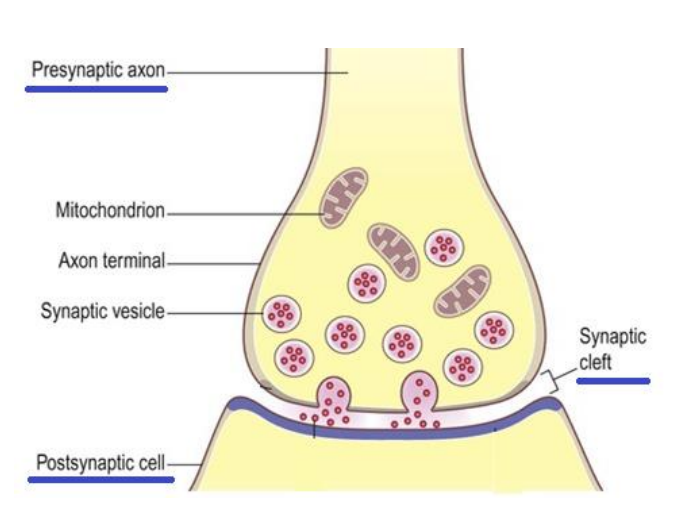
Process of synaptic signal transmission
• Action potential arrives at axon terminal
→ causes voltage change in the presynaptic membrane
→ calcium channels open: calcium ions rush in
→ calcium influx causes vesicles to dock at presynaptic membrane
→ vesicles release neurotransmitters into synaptic cleft
→ neurotransmitters bind to specific receptors on postsynaptic membrane → causes voltage changes in postsynaptic membrane (De- or Repolarization)
depending on the receptor, transmitters have excitatory or inhibitory effect
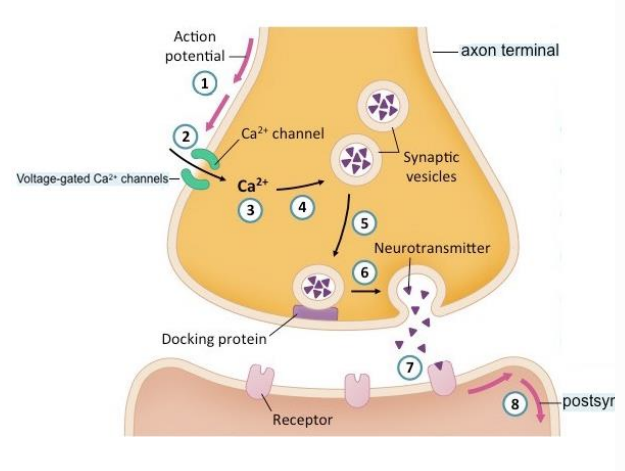
Excitatory post-synaptic potential (EPSP) 1
excitatory effect - AP can be evoked
neurotransmitters bind to specific receptors on postsynaptic membrane
sodium (Na+ ) channels open in the postsynaptic membrane
→ Na+ ions rush in
→ positivity causes a small depolarization of the cell membrane = EPSP
! Excitation of neuron caused by depolarization of the membrane
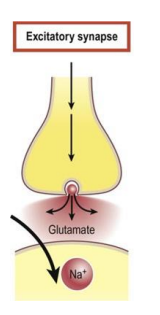
Excitatory post-synaptic potential (EPSP) 2
mechanism of triggering an Action potential at Axon hillock same as the propagation of an AP along the axon
transmitter bind to receptor of postsynaptic membrane → causes Na+ channels to open: influx of Na+ ions • Na+ ions move to Axon hillock
once Na+ ions reach Axon hillock, membrane becomes less negative
when threshold of -55mV is reached Na+ channels open
→ Na+ influx, i.e. an action potential occurs & spreads along the axon
Excitatory post-synaptic potential (EPSP) 3
To trigger an action potential:
numerous synapses need to be activated to have an impact at the axon hillock
2 ways
spatial summation - combined effect of different neurons all reaching postsynaptic neuron together
temporal summation - same synapses activated repeatedly
location of contact: synapses closer to axon hillock have stronger influence on target cell
Inhibitory postsynaptic potential (IPSP)
Inhibitory effect - less likely to generate an AP
What happens when there is an inhibitory effect?
Action potential reaches presynaptic membrane
→ causes calcium channels to open: influx of calcium
→ transmitter bind to specific receptors on postsynaptic membrane
→ !! chloride (Cl- ) channels open → negative ions rush in
→ causes hyperpolarisation (inside of membrane becomes more negative) = IPSP
! Inhibition of neuron caused by hyperpolarisation of the membrane
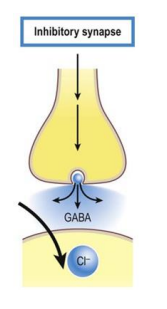
IPSP Function
Balance between excitatory and inhibitory neurons
preventing excessive firing of neurons
e.g. Epilepsy - this balance doesn’t exist = neurons fire uncontrollably
Neurotransmitters
maintain signals in the nervous system by binding to receptors on post-synaptic neurons
all serve a different purpose in the brain and body
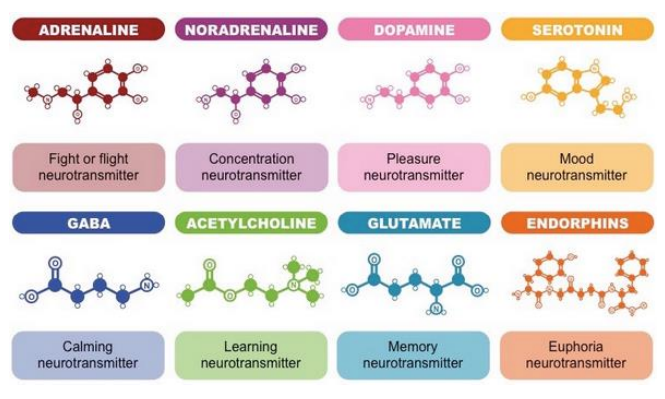
Glutamate
involved in learning & memory
regulates development & creation of new nerve pathways
GABA
(gamma-aminobutyric acid)
major inhibitory neurotransmitter
Serotonin
involved in regulating body temperature, sleep, mood, appetite, & pain
reduced → e.g. depression, aggressiveness
Dopamine
involved in controlling movement & posture
reduced → e.g. Parkinson’s Disease
affects cognition
reduced → e.g. poor concentration
affects behaviour
increased → e.g. schizophrenia
Acetylcholine (ACh)
PNS
neurotransmitter at neuromuscular junctions
triggers muscle contraction
Myasthenia Gravis (muscle weakness) = blocked/attired/destroyed ACh receptors
Botox - prevents release of ACh from axon terminals at neuromuscular junction
CNS
- neuromodulatory fxn - can be inhibitory or excitatory
Electrical synapses (gap junctions)
less common
pre- & postsynaptic membranes are connected
→ presynaptic cell affects postsynaptic cell directly & electrically → electrical signal travels straight over to the other cell, evoking depolarization
→ postsynaptic reaction arises almost at the same time as the presynaptic potential
evokes a more synchronized effect; faster (~0.1-0.5ms) than chemical synapses (~1-5ms)
Present in the heart, reflex pathways, retina, and some medulla connections